IoT Software Development: an All-In Brief
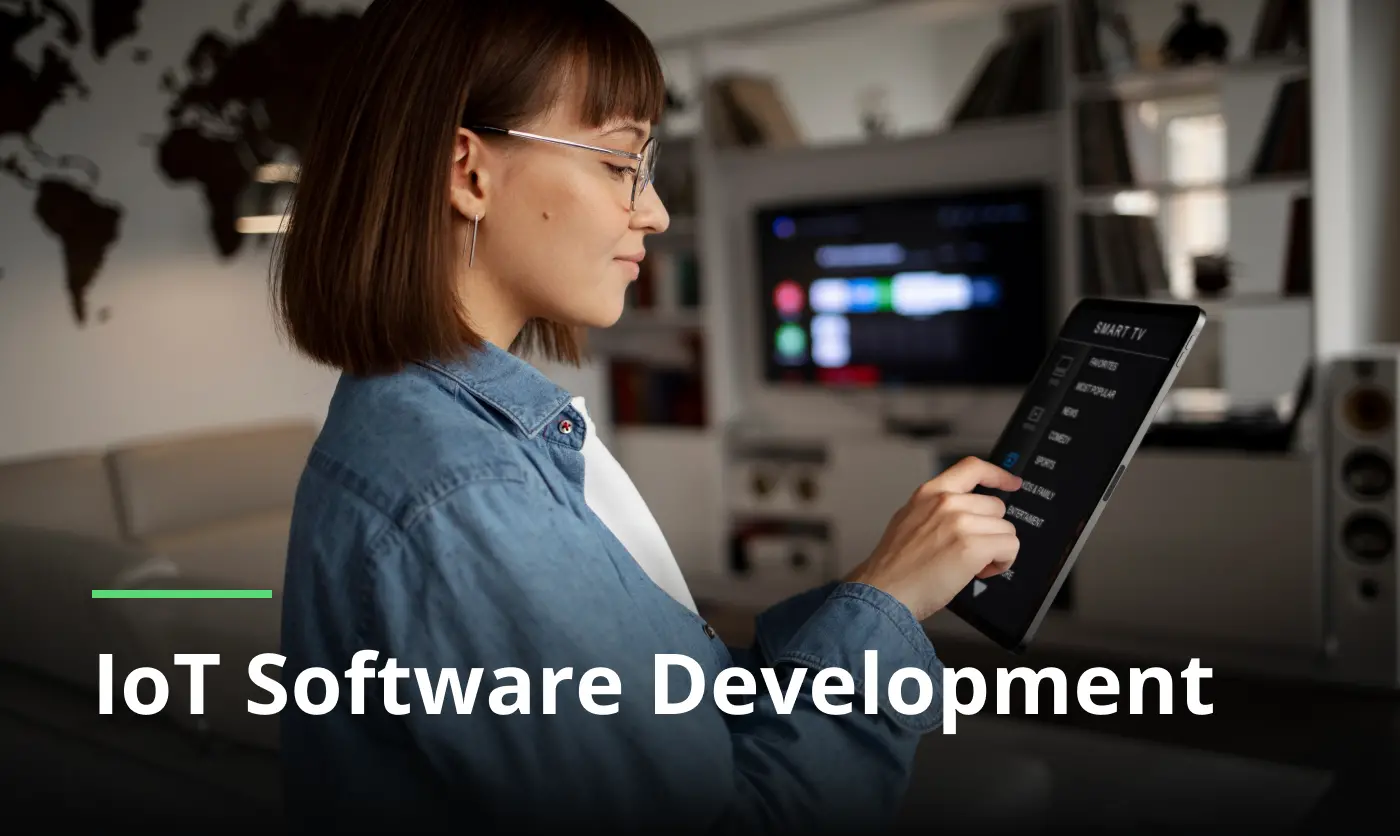
Custom software development for IoT is a go-to solution for businesses that helps increase efficiency and significantly improve the user experience, opening new possibilities for reducing costs and cutting waste time on manual activities. In this extensive summary, we gathered the most essential points you need to be aware of when building applications for interned-connected devices.
Explaining the fundamentals of Internet of Things software development, we highlighted such facets as the detailed roadmap of the programming process, the features that can’t be overlooked and the tech suite used by coders to deliver smart home automation systems. To leave no stone unturned, we specified the prices for software development services, and also outlined a plan following which you’ll easily pick an innovation-driven firm to realize your idea.
What is an Internet of Things software?
Checking whether you really turned off your iron, controlling your air conditioner from your phone to save energy, and at the same time coming into a cool apartment, or adjusting your headphones in the way that your favorite music sounds wonderful — they are achievements of responsive applications. Now, they are revolutionizing retail, farming, healthcare and many other industries by driving automation and analytics.
About 17 billion appliances are fused by this technology and the number is going to surpass 30B in 2030. From individual households to factories and enterprises, people adopt smart electronic programs to accelerate routine work and to use resources in an effective manner. Such IoT software development solutions are delivered by a dedicated development team from programming companies who possess knowledge of the engineering approaches and markets.
How to build IoT software: action-by-action guide
Below, we summarized the full cycle of undertaking a venture. Keep reading to be in the know of stages of whapping things up:
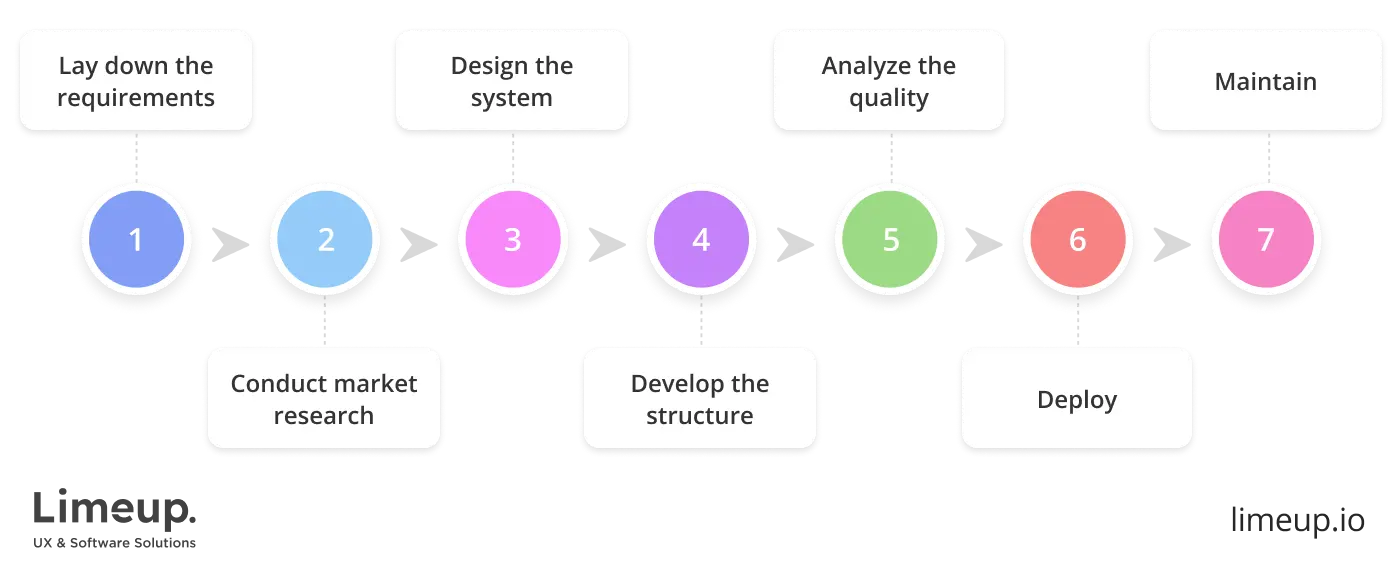
Step 1. Lay down the requirements
The first brick in the wall to put up is defining your expectations. Reading synopsis like ours, familiarizing yourself with the benefits and challenges, aspects like IT stack and carrying out a project, you obtain valuable insights into the implementation cycle to understand who you need to seek and how it goes.
Certainly, it’s not like you have to be informed about each tiny nuance — brainstorming with a seasoned IoT software development team will clear the clouds entirely. However, it’s crucial to see a distant picture in the form of the benchmarks you aim to reach, the functions you want to be embedded in and the timespan you find appropriate. Having clarified your objectives, you’ll prevent misalignment in your targets and in the innovative hive’s mighties.
Step 2. Conduct market research
The following phase is necessary to discover essential takeaways that will empower an intelligence-led strategy. Throughout this activity, digital natives meticulously scrutinize the industry, pinpointing the trends, competitors and audience’s preferences. They identify operational inefficiencies and offer solutions that will resolve crucial concerns.
The scenario of demand forecasting in Internet of Things software development isn’t simple, yet it is very fruitful in findings. For example, you are planning to launch a home system that will send owners notifications about the level of humidity and temperature. By surveying people, you determine in which aspects the dominating propositions don’t fully satisfy prospects.
Step 3. Design the system
Understanding the obstacles your potential customers face and how you can turn their challenges into opportunities, digital transformation experts craft appealing layouts with intuitive navigation so that a technology beneficiary won’t struggle with controlling the program and will quickly grasp the principles of its work.
To understand what is IoT software development’ value, 2 out of 3 devices created now are paired to the web, with the market worth projected to exceed $1.5T revenue in 2029. That’s why an executable, to be truly successful, must have a well-thought-out UI/UX roadmap to stand out. Delivering data visualization in a concise and readable manner is a key item in this rapidly changing landscape.
Step 4. Develop the structure
This is when programmers implement the server-side technologies that propel the application. They leverage the security protocols, preventing data leaks and ensuring that the deliverables can withstand attempts of digital theft. Additionally, professionals integrate third-party linking and write code for functions.
The latest trends in defense include blockchain ledgers, making them especially invulnerable. We can’t help but mention the rise of AI and ML tools, enabling users to receive analytics fueling informed decisions. And, of course, with the appearance of the 5G Internet, sensor-based equipment enters its prime time due to the possibility of sending immediate updates.
Step 5. Analyze the quality
To ascertain that the outputs meet the highest standards, the thorough evaluation is performed after engineering. It is an unavoidable step if you are targeted at architecting balanced and errorless utility.
Being as multilayered as any other IoT software development services, checkups incorporate an expensive list of procedures: a performance test, a security assessment, functional inspection, compatibility, reliability and usability, in addition to verification of regulatory compliance.
Step 6. Deploy
Speaking of launching, in the world of wireless tools, it happens in several ways, depending on the type of product. For example, a farming instrument can be released on platforms and websites via edge and cloud, while healthcare systems may be published in mobile stores or on manufacturers’ portals.
The intricacy of release is explained by its complex stratification. Unlike usual apps, embedded assets are related to hardware appliances, which adds a layer of entanglement since professionals need to ensure good alliances and impeccable running across various sources, from the sensors to the linkage.
Step 7. Maintain
The moment your offering is disclosed, the groundwork is done. However, we can’t say that there’s nothing that should be done afterward since, to work without interruptions, a network requires regular revisions and checks.
Monitoring the code means applying emerging trends, hastening the operations, troubleshooting errors and adding new attributes.
It may feel like a long path, yet finalizing it, you secure positive outcomes.
What are the features of custom software development for IoT?
As with the formation, functionalities of a network are multi-faceted, designed to embrace all the fundamentals such an undertaking carries. With the intention of capturing the general characteristics, we outlined the most spread ones that you can typically meet in an abundance of utilities:
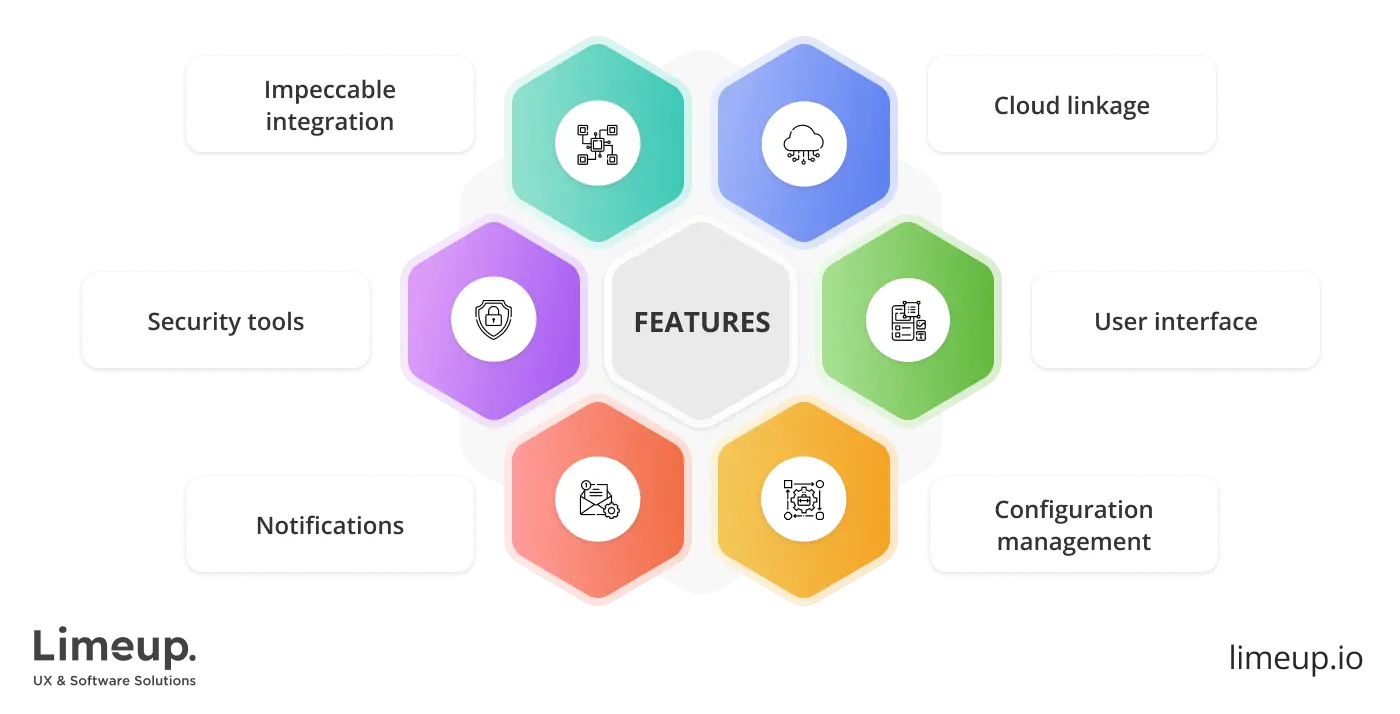
Impeccable integration. At the forefront of an intelligent technology platform stands its ability to sync with different apparatus and provide analytics, which is the crux of the exchanging files between devices and cloud resources.
Programmers are tasked with engineering means that allow users to receive instant reminders and make immediate changes — for instance, if it’s important to raise or lower the intensity of light.
Cloud linkage. IoT software development of up-to-date tools is difficult to pretend without cloud-hosted solutions. They are the power that makes the data examination more efficient since it’s collected and stored for evaluation. As the engine that processes the input and the instruments that allow remote management, they became irreplaceable wheel cogs.
From real-time observations to maintenance and administration, everything is enhanced by adopting virtualized approaches.
Security tools. No matter the industry you are oriented on, safeguarding will always be the direction of special attention. When selling your products to individual buyers, gearing toward manufacturing and automotive businesses, or looking for means that will advance your venture, protection needs to be as solid as possible.
First of all, the protocols that prohibit accessing information from unauthorized sources should be installed. The defense must touch not only the program but the hardware as well, the network, cloud and APIs. When you address your concerns to experienced IoT software development companies, abiding by all these rules becomes not an obstacle but an achievement task.
User interface. Whether your audience is prepared or, on the contrary, never dealt with remote systems, creating a usable and accessible panel will help you hit your milestones. The dashboard must have settings that help bridge or disengage the tools, locate them within the area and list the available appliances.
A person controlling them remotely should be able to set preferable ways of work, like scheduling routine tasks or light react when someone moves. Also, it’s not rare for people to be given the opportunity to scroll through trends and predictions that will transform how they employ the products.
Notifications. In medicine, receiving real-time alerts from wearables determines life. In agriculture, the on-time message of a problem with crops defines the harvest. For an individual, getting notes about low battery or a high level of humidity in their house simplifies daily grind and prevents minor and major disappointments.
It works in the way that sensors collect datasets, send them to computation tools and when it catches any misappropriation, a warning appears on screens.
Configuration management. High-end adjustments can’t help but have interfaces where adopters settle the preferable conditions. A climate control app must have a panel where it’s possible to specify the preferable patterns and schedule changes.
The range of custom IoT software development services is wide and the only thing that defines their variety is your ideas. Apart from the core functions, a user must have an opportunity to establish personalized message delivery setups and choose the network parameters — like switching between Wi-Fi and cellular connectivity alongside cloud management.
These are the key aspects of a program, but the real extent depends on your expectations.
Tech stack for Internet of Things software development
Recognizing the suite of technologies imperative to complete your undertaking, you won’t wonder which skills to look for in specialists. It will also give you inspiration to question their capabilities thoughtfully.
Let’s grasp the essentials that will empower your initiative:
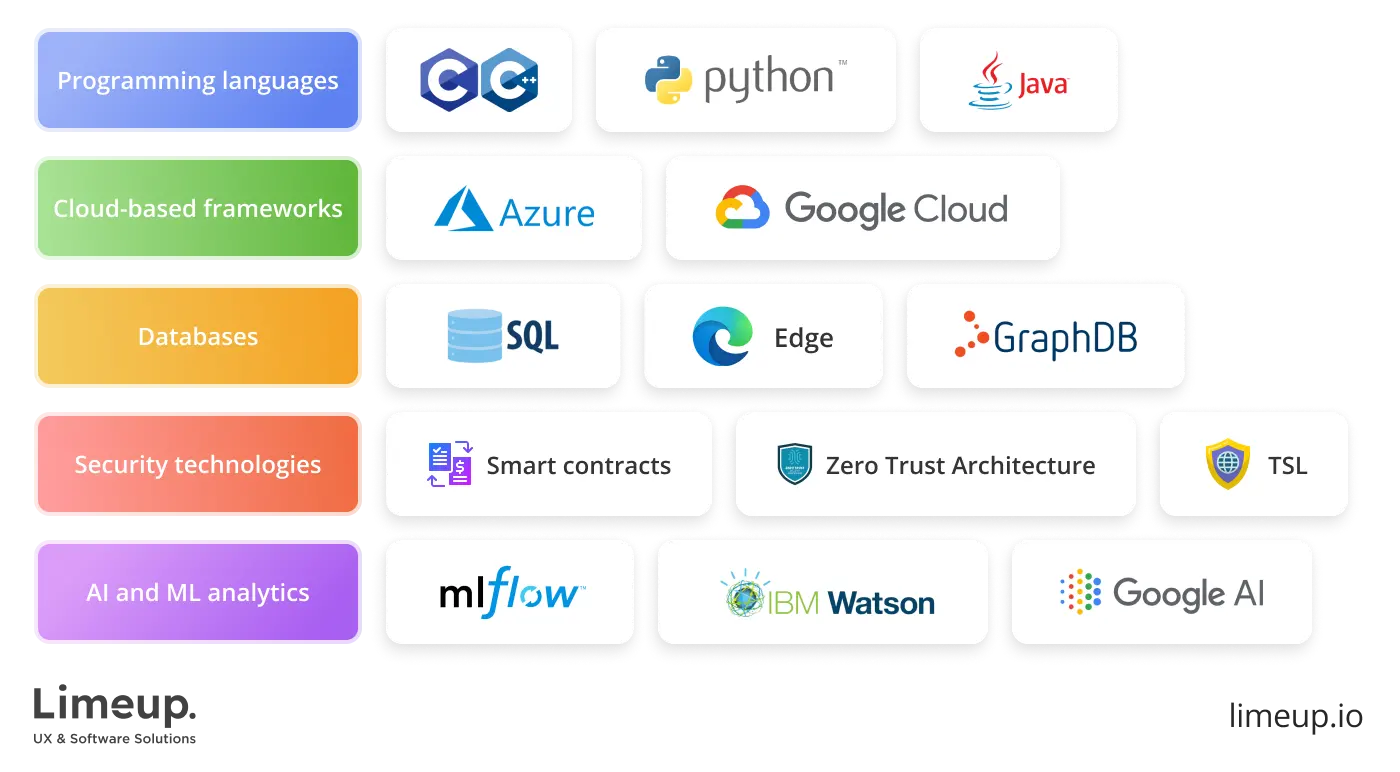
Programming languages
There is a selection of popularly embraced options engineers pick:
- C / C++ — are primarily used for writing codes for low-power systems and are one of the most spread languages for edge-unified devices. They can be applied when you need solutions that don’t consume too much energy with instant processing.
- Python — has its benefits in situations when one of the goals is to leverage AI and ML advancements in addition to cloud integrations. It also shows effectiveness in prototyping.
- Java — targeted at creating enterprise-level applications, an IoT software development company chooses Java since it’s perfect for big data merging. Systems written in Java are capable of handling information from an abundance of sensors, being a decent choice for industrial or sustainable city projects.
Cloud-based frameworks
Accelerating a launch without sacrificing the quality of an endeavor is something that cloud technologies help achieve. You’ll find quite a lot of them, but the most popular ones are:
- Azure — it’s a treasure trove regarding protection and building scaled networks. The utilization methods of this strategy encompass engineering itself, deployment and maintenance.
- Google cloud — there is a similarity between the previous instrument and this, however, speaking of adopting Artificial Intelligence tools, it demonstrates more cons and comes cheaper.
Databases
Taking into account that the machines connected to the web need to get and output tons of records, videos, texts and signals, choosing the right storage and analytic infrastructure is as important as outlining its features. Their variety is wide, so a proficient IoT software developer will figure out what way to opt for out of the summarized:
- SQL — they store information of different grades, such as people’s profiles, setups in a structured way, impeccably complying with the standards of ACID.
- Edge — secure instant data manipulation, afford intermediate scalability and support offline assistance.
- Graph — is actively incorporated for the projects when there is a big digital dependency.
Security technologies
Encrypting the actions and the records people give access to is the task that requires utmost attention. The methodologies underline only a drop in the ocean of the existing means, and there are many variations within one solution, oriented on different aspects like strengthening the code so that it will be able to withstand a hacker attack, embedding functions that will cover sensitive files and so on:
- Smart contracts — this program is irreplaceable when it comes to avoiding fraud. Instead of relying on external means, this blockchain technique reacts when certain conditions are met, and the predetermined actions happen (a user receives an alert).
- Zero Trust Architecture — aiming to obtain a system that won’t take any users by default, this framework is what will help you reach such a goal. Implementing such a structure, you’ll be sure that no one on the network will be recognized as the “safe person”, reducing the chance of unauthorized access.
- TSL — this strategy is necessary to make sure that the figures transmitted from one device to another or the server won’t be intercepted by third parties. It protects the exchange between integrated home appliances.
AI and ML analytics
Establishing predictive instruments with artificial intelligence revolutionized the outputs. Such functionalities rapidly enter various cycles of engineering, resulting in producing a new level of deliverables:
- MLFlow — an open-source utility that allows machine learning models to be tracked. It’s mostly used for maintenance and detection of anomalies.
- IBM Watson — thanks to these instruments, you can receive top-notch automation and accurate analytics with a matchless level of safeguarding.
- Google Cloud AI — if you need computed speech and vision alongside prognosis, this tool can be a workable solution for scalable projects.
From this list you can see that constructing internet-linked electronics, programmers need to be aware of its many facets, ascertaining that these parts effectively synchronize.
How much does IoT software engineering cost?
Budget formation isn’t the simplest matter to lay straight away as it requires taking additional factors into account to make evidence-based decisions.
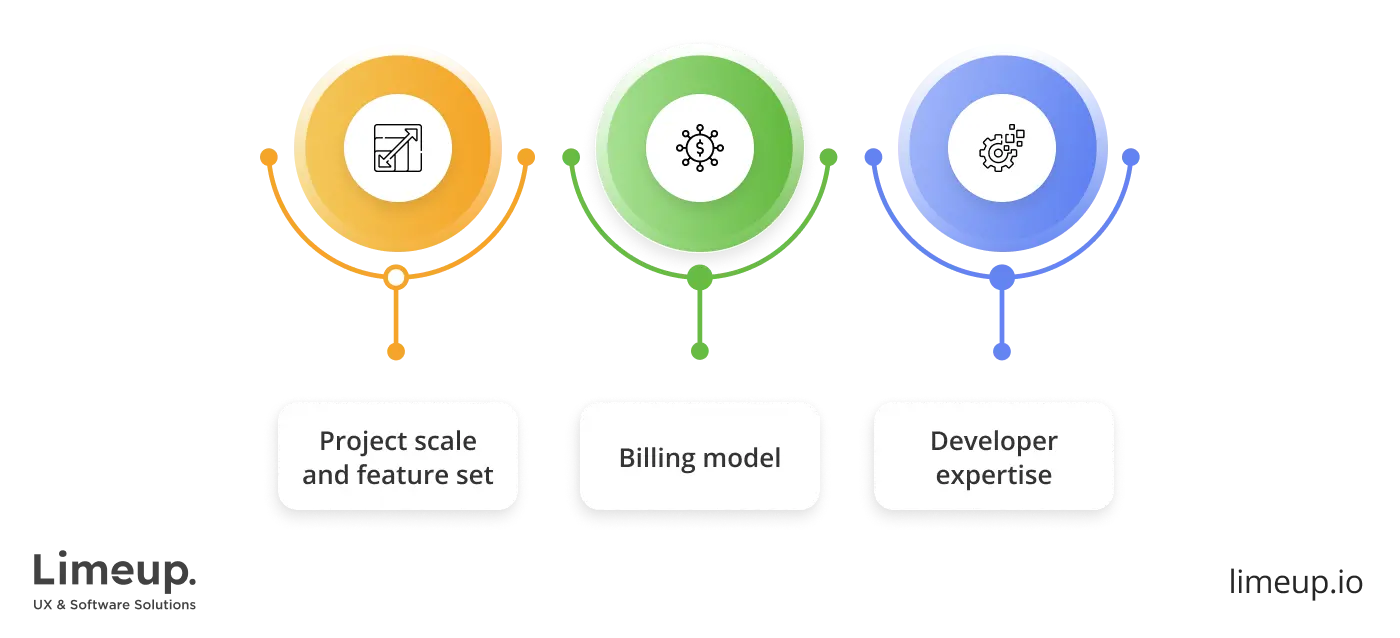
To help you gather an understanding of pricing policies, we underlined figures, considering the imperative aspects like the level of the executors’ expertise and the scale of an endeavor. You can grasp even more by studying software development cost.
In the table further down, you’ll find the approximate hourly tariffs according to the degree of skill:
| Tier of proficiency | Wages |
| Juniors | $30 – $50 |
| Middle specialists | $50 – $100 |
| Seniors | $100+ |
If the specifications of your venture are not too complicated, namely basic settings, it might be that a beginner or moderate level Internet of Things developer will be able to meet your criteria. Speaking of enterprise endeavors, the help of professionals who can supervise the nuances is vital.
Below, we categorized undertakings, having divided them into three groups, from the starter to the advanced extent, adding rough estimations and components of deliveries:
| Grade of the project | Instances | Expenditure plans |
| Elementary | Light and temperature controllers and watering systems navigated through Wi-Fi | $10,000 — $20,000 |
| Intermediate | Smart home security, equipment and wearables monitoring. | $20,000 – $100,000 |
| High-end | Crop observing using drones, production automation, fleet administration. | $100,000+ |
Now, let’s dive into the explanations of the subsidiary aspects:
- Technologies — integrating sophisticated Artificial Intelligence and Machine Learning adjustments as well as blockchain blockchain improvement is a game-changing strategy concerning satisfying the end user, yet the tags for these mechanics differ from classic skills like Python versatility or Java.
- Pricing model — charging approaches don’t directly influence the final meanings, however, they can impact them over the course of IoT software development. To illustrate, we will give a case: teaming up with a vendor on an hourly basis, the span of work prolongs and the initial blueprint expands. Or, having agreed on fixed payment terms, you can find that it lacks flexibility.
It’s important to single out the method that will be beneficial for you, because how you pay matters as well.
- Infrastructure expenses — linking the program to external parties, using cloud solutions and leveraging patented instruments bring an extra dimension to the bill. AWS, Google and IBM Watson subscriptions also cost money.
How to choose an IoT software development company?
The previous sections showed you that building connected device systems isn’t trivial due to its complex structure. Further in our synopsis, we deliberated on the candidate evaluation procedure that will help you make data-driven decisions and be sure that the cooperation will run smoothly. Follow the guidance gradually to take full advantage of it.
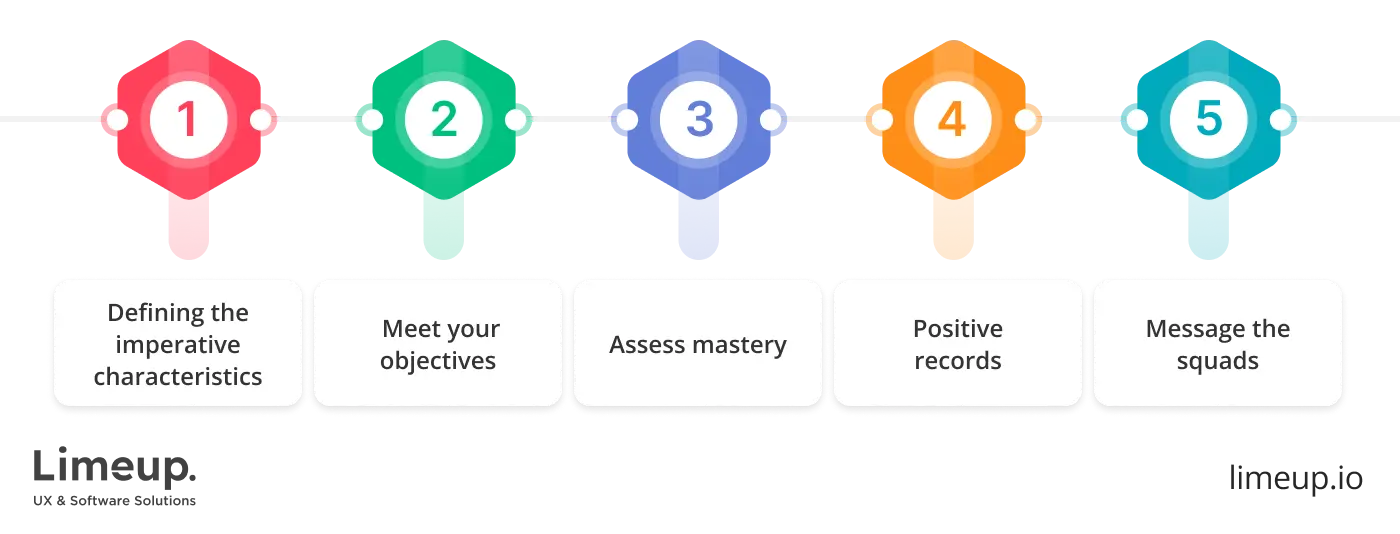
First and foremost, defining the imperative characteristics of the firm you want to partner with is crucial. We recommend that you consider both primary and supplementary factors. Experience in completing similar projects, availability of a broad spectrum of competencies and enough workforce to deliver multilayered workarounds are the key aspects to consider when you hire software developers while a common time zone and cultural fit are secondary.
As soon as the list of your preferences is ready, gather IoT software developers who meet your objectives. There are many paths you can take to get in touch with accomplished tech visionaries, from scrolling through listings of studios where they are collected to suit certain requirements. Picking a few out of them and contacting them will greatly save you time since they already match the services and specialization.
Another way is to reach out to your business partners and ask for advice from them, whether they are familiar with teams of engineers and can recommend them.
It doesn’t matter if you select the first or second route, the next step can be overlooked. You need to assess mastery. Explore their websites to find evidence of their versatility regarding software development for IoT. It includes evaluating success stories and observing tech stack and their offerings.
When you opt for a few potential contenders whose capabilities align with your expectations and whose image you consider trustworthy, ascertain that they have positive records on independent resources. Conduct extensive research to be sure that they have obtained all the necessary licenses and are really credible. If a supplier can’t be trusted, you’ll quickly locate all the uncertainties only by googling their names.
Finally, having proof in your hands, message the squads. A few lines from you don’t mean that you sealed the deal; you can write as many firms as you want to get their quotes to clarify the details of custom IoT software development. Adopting this approach will shed light on their responsiveness and work conditions so that you’ll be able to single out the right team.
Final thoughts
Gadget-connected technology has entered many industries, dominating in the entertainment domain, capturing healthcare, manufacturing, retail, food and beverage production and many others. Giants like Google, Microsoft, Apple and Amazon explore this direction, offering cutting-edge advancements, revolutionizing each aspect of life and changing how we perceive goods and services.
There are standards businesses have to follow to break new ground. Software development for IoT also has strict regulations with an additional tier of complexity in the form of multiple sources management. But the market predictions show us that in the future, it will be one of the most adopted approaches to delivering high-quality products, and that’s why diving into this landscape is so beneficial despite the hardships.
Summing up the stated, we’ll specify three components that help to bring your idea to fruition: first, well-defined objectives, fueled by data about a target audience’s pain points, second, a carefully planned crafting and third, joining efforts with seasoned forward-thinking programmers. Contacting Limeup, you’ll be able to cater to all the strategic priorities.

